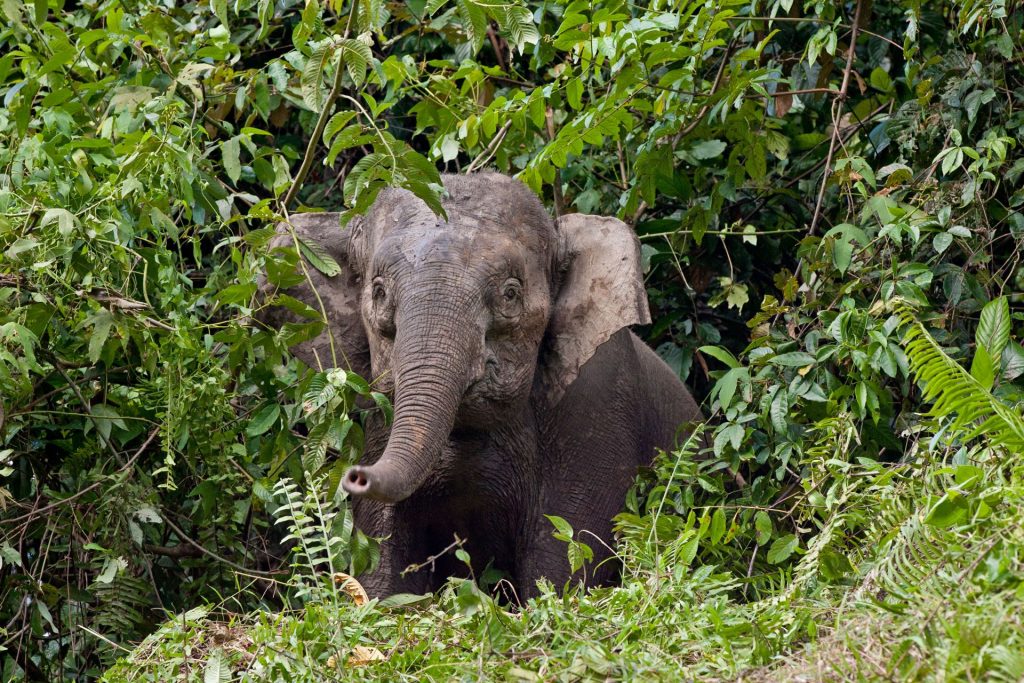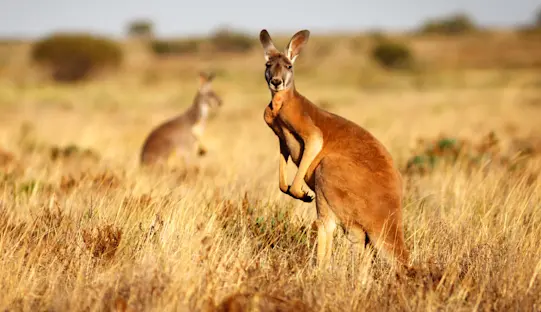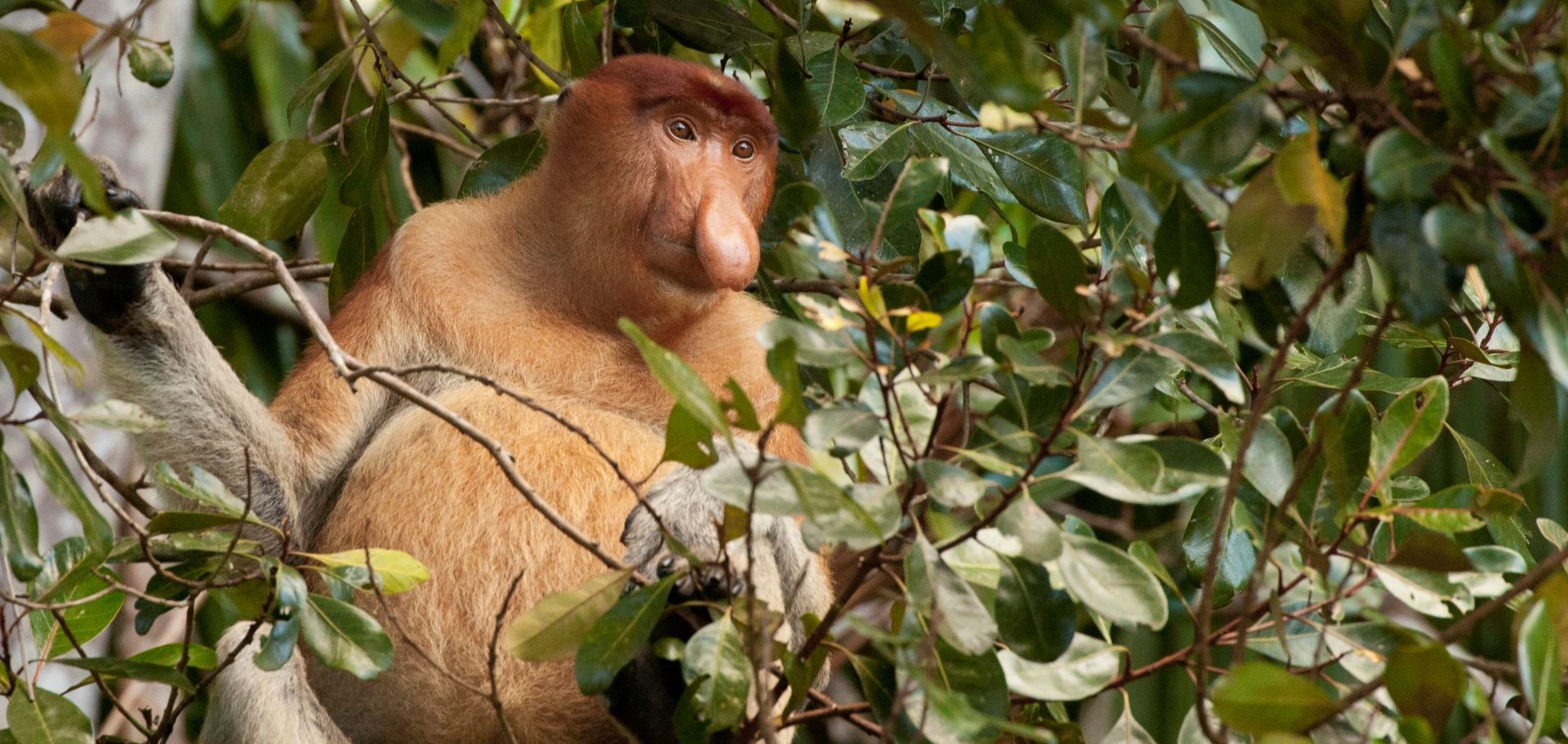Borneo’s tropical rainforests rank among the most biodiverse ecosystems on Earth. More than 130 million years old—making them 70 million years older than the Amazon—these ancient forests harbor creatures as extraordinary as they are unexpected. Here, scientists have discovered a lungless frog that breathes through its skin, a so-called “ninja slug” that fires love darts at its mate, the world’s longest insect, a deer that barks, and even tiny pygmy elephants. It’s no wonder Borneo is considered a wonderland of bizarre and astonishing wildlife.
The numbers are just as impressive: roughly 222 species of mammals (44 found nowhere else), 420 birds (37 endemic), 100 amphibians, and 394 fish (19 endemic). Between 1995 and 2010 alone, researchers identified more than 600 new species—an average of three per month—and over 50 of these were entirely new to science.
Let’s meet some of the unique creatures you can hope to meet on a Borneo adventure:

Orangutan
Orangutan translates to “man of the forest,” which makes sense given this primate’s uncanny human resemblance. Like us, orangutans have four fingers and a thumb and fingernails. These highly intelligent animals with shaggy reddish fur live in the lowlands and are relatively solitary. They make nests in trees of vegetation to sleep at night and rest during the day, making them the heaviest tree-dwelling animal. They have prominent cheek pads called flanges and a throat sac used to make loud verbalizations.
Sadly, orangutan numbers are sharply declining due to habitat being lost at an extremely high rate from the conversion of forests to oil palm plantations and other agricultural development. Fires also destroy massive areas of orangutan habitat. Despite legal protection in Indonesia since 1931, orangutans are still captured and kept in households as status symbols or hunted as food. Females give birth to just one infant every eight or nine years, making their populations very susceptible to even low levels of hunting.
Orangutans feast on wild fruits like lychees, mangosteens and figs and play a vital role in the dispersal of seeds over a huge area. If orangutans were to disappear, so would several tree species.
Proboscis Monkey
The proboscis monkey, or nasalislarvatus, is a weird little reddish–brown primate with a long nose (we’re talking up to 7 inches in males!). In this species, size really does matter. The longer the nose, the better to attract a potential mate. It also serves to amplify the sound of warning calls. Living on a diet of mainly mangrove shoots and insects to maintain its distinctive pot belly, the proboscis monkey is a strictly protected animal, with experts suggesting that there are only around 1,000 remaining in the wild.

Sun Bear
A far cry from the life of a polar bear, sun bears (also known as honey bears) live in the dense lowland forests of Southeast Asia. A nocturnal and shy species, they are rare to see in the wild. The sun bear is arboreal, so you’ll need to keep your eyes on the trees if you want to see one. You can tell the sun bear from other species from the distinctive horseshoe marks on their chest—no two markings are ever the same! Their tongues are up to 10 inches long and help them to satiate their voracious appetite for honey.
Sun bears are essential members of their ecosystem because they help disperse seeds while also keeping pesky termites in check. Unfortunately, their global population has declined 30% over the last few years, making them the second-rarest bear species next to the Giant Panda. On our Nat Hab Wilds of Borneo tour, we have the chance to enjoy a private visit to the Bornean Sun Bear Conservation Center. Founded in 2008, the center provides care, rehabilitation and release of orphaned and captive sun bears and increases awareness about the plight of this little-known bear.

© Frendi Apen Irawan
Sunda Pangolin
The critically endangered Sunda pangolin has been called an “artichoke with legs.” These prehistoric animals have existed for 80 million years. This funky little critter is the only mammal covered in protective keratin scales and has a freaky tongue that stretches out longer than its body. Lacking teeth, this long, sticky tongue serves to collect ants and termites. Though we know they feast on a diet of ants and insects, there’s still little known about these elusive, nocturnal animals with prehensile tails. We do know that when threatened, they protect their soft underparts by crunching into a roly-poly ball.

Sambar Deer
The nocturnal sambar deer is one of the biggest species of deer in the world. Adult males can reach a length of more than 7 feet and weigh more than 440 pounds (one on record even came in at over a thousand pounds!). They are at home in the Bornean rainforests and are some of the easiest animals to spot at dusk. They are timid, but when disturbed, their first instinct is to freeze before responding to predators with loud barks called ‘pooking’ or ‘belling.’ They also dramatically stomp their feet, and their mane will rise in a confrontational manner. They have been listed as a vulnerable species on the IUCN Red List since 2008.
Microhyla Nepenthicola
It’s probably easiest to call it by its other name, the “Matang narrow-mouthed frog.” This newly discovered species is around the size of a pea, making it the second smallest frog in the world, and it loves to live around pitcher plants in Kubah National Park. They were discovered after scientists tracked the unique and powerful croaks of the males. While they are physically tiny, their voice is huge and travels far distances.

© Bernard Dupont
Horsfield’s Tarsier
These wonderful weirdos with excellent leaping and climbing skills look quite similar to Yoda. They are nocturnal, and their massive yellow eyes help them maneuver through the dark. The size of one of their eyeballs is the same size as their brain, making them the largest-eyed mammal in the world relative to their body size. The forward-facing slope of their eyes allows tarsiers to accurately assess distances for safe leaping—helpful, considering they can leap up to 18 feet. Tarsiers are also capable of turning their heads nearly 180° in each direction, meaning that they can rotate their heads almost 360°.
While they may come across as cute, tarsiers are the only living carnivorous primate species, and they use their dexterous hands to aggressively ensnare their prey. Their medley of insect snacks includes beetles, cockroaches, locusts, moths, grasshoppers, butterflies, ants and cicadas. For a feast, they will go after birds, bats, frogs and snakes—including poisonous species.
Mouse Deer
While not technically a deer or a mouse (it’s actually classified as a tragulidae), this nocturnal and solitary critter reaches a not-so-towering height of barely 12 inches, making it the smallest hooved animal in the world. Overachievers, these females can conceive just two hours after birth, and newborn fauns can stand after 30 minutes. They are found on forest floors feeding on leaves, shoots, fruits and sometimes even fungi.
With round bodies and spindly legs, they look almost like a stuffed animal—but inside that cute little mouth are some mighty fangs. A male will angrily beat his hooves when agitated or to ward off predators and warn other mouse deer of danger. Although they are land mammals, they can hold their breath for up to four minutes and often leap into the water to escape predators.

Borneo Pygmy Elephant
The smallest elephant in the world is among the cutest animals in Borneo, with its oversized Dumbo ears and long tail. Although it grows to about 9 feet tall, the Bornean pygmy elephant is still the largest mammal on the island. Because of deforestation and hunting, estimates suggest only 1,500 to 3,000 remain in the wild, putting the friendly and adorable elephants in dire need of protection.
Once believed to be remnants of a domesticated herd given to the Sultan of Sulu in the 17th century, Bornean elephants were determined by WWF to be genetically different from other Asian elephants. DNA evidence proved that these elephants were isolated about 300,000 years ago from their cousins in mainland Asia and Sumatra.

© Spencer Wright
Clouded Leopard
Preferring to live in the treetops, this elusive leopard possesses an incredible ability to climb and hunts smaller mammals, including deer, pigs and even monkeys. Given their nocturnal and stealthy nature, seeing a clouded leopard in the wild is extremely rare. It’s been called the most beautiful wild cat on Earth and is Borneo’s only big cat. Currently listed as Vulnerable on the IUCN Red List of Threatened Species, the best chance of spotting the clouded leopard is in Deramakot Forest Reserve.

© Brad Josephs
Hornbill
Hornbills are known for their unusual double-storied bill, but also noteworthy is that they have their own ‘language.’ They seem to speak to each other in a sort of Morse code whose noise resembles that of a steam engine. This form of communication is how a male hornbill sends messages to his mate through the barricade she makes during her nesting period. The pair builds a nest in a tree hollow, and once the eggs are laid, the male seals the female in the hollow, using mud and feces to construct a wall. Only a small hole is left so that the male can pass the food to the female and to the chicks once they are hatched.
Hornbills are incredibly loyal to their families, mate for life and will band together to defend each other against predators. Hornbills have an important place in local culture, signifying nothing less than the Spirit of God. It is said that if a hornbill is spotted flying over your home, good luck will be granted to the whole community.
Saltwater Crocodile
Crocs are easy to see sunbathing on the banks of Kinabatangan River. Even though these are the saltwater crocs—the most dangerous crocodiles on Earth—locals seem to have a peaceful relationship with these animals, which are much smaller than their Australian cousins.

Sumatran Rhino
Sadly, the Sumatran rhino is on the verge of extinction. It’s unclear exactly how many remain, but estimates suggest fewer than 100 live in northern Sumatra and Borneo. The Sumatran rhino holds the title of the smallest rhino in the world. Their bodies are covered in long hair, they’re the only two-horned rhinos in Asia, and they have a reputation for being so elusive that even rangers rarely see one. So while it would be wonderful to spot one on a Borneo adventure, realistically, you just have to be happy knowing that they still exist.
Bornean Slow Loris
The Bornean slow loris (Nycticebus borneanus) is a primate that more closely resembles a tiny, wide-eyed lemur. Despite its adorable appearance, it holds a rare distinction: it’s one of the few venomous mammals on Earth. This nocturnal creature uses its toxin—secreted from glands near its elbows and activated by licking—to deter predators. Sadly, its cuteness has made it a target in the illegal pet trade. Before being sold, individuals often endure brutal treatment, including having their sharp teeth clipped with nail cutters—typically without anesthesia—to render them less dangerous. This cruel practice, coupled with habitat loss, makes the pet trade one of the greatest threats to the species’ survival. The Bornean slow loris is currently listed as Vulnerable on the IUCN Red List. Central Borneo is home to the largest populations, and remarkably, new species of slow loris are still being identified today.
Ninja Slug
This green and yellow slug (Ibycus rachelae) was recently discovered on leaves at altitudes up to 6,200 feet. The slug boasts a tail that’s three times the length of its head, which it likes to wrap around its 1.6-inch-long body as if it were acting like a cat. In fact, its discoverers originally wanted to name the slug Ibycus felis, after this feline inspiration.
The slug species quickly made a name for itself because of its so-called love darts. Made of calcium carbonate, the love dart is a harpoon-like structure that pierces and injects a hormone into its potential mate, increasing the slug’s chances of reproduction.

© Brad Josephs
Red Giant Flying Squirrel
Red giant flying squirrels are some of the most abundant animals in Borneo, and if you spend any time in the jungle at night, you are pretty much guaranteed to see them. Borneo has a variety of flying squirrels, but the red giant flying squirrel is by far the largest of them all. But know that they don’t actually fly—they simply glide over large distances with the help of a flying membrane flap of skin that extends from their front feet to the back feet.
Chan’s Megastick
This enormous stick insect, Phobaeticus chani, is believed to inhabit the high rainforest canopy, making it especially elusive and difficult to study. Even though it’s an insect that’s almost 2 feet long, very little is known about its biology and ecology. In addition to being the world’s longest insect, the species also wins the insect world record for the longest body, measuring an impressive 14 inches. Only three specimens of this extraordinary creature have ever been found, all of them from the heart of Borneo.
Bornean Flat-Headed Frog
It may be small—less than 3 inches long—but the Bornean flat-headed frog holds a remarkable distinction: it’s the world’s first known lungless frog. Though initially discovered in 1978, scientists only uncovered its astonishing adaptation in 2008. Rather than relying on lungs, this frog breathes entirely through its skin—a rare trait among amphibians. With internal organs occupying the space where lungs would normally be, its body takes on a noticeably flattened form. This sleek shape isn’t just odd—it’s functional, helping the frog glide effortlessly through the swift, rocky streams of its rainforest home. Unfortunately, this extraordinary amphibian is endangered, its future uncertain as its habitat continues to shrink.
Ready for an adventure to seek out Borneo’s rare and remarkable wildlife? Expedition Leader and pro photographer Court Whelan shares his advice for revealing the mystique of Borneo in the Daily Dose of Nature below, including how to photograph animals in trees, tips for perfecting your wildlife portraiture, and how to use exposure and color balance to convey mood.
































